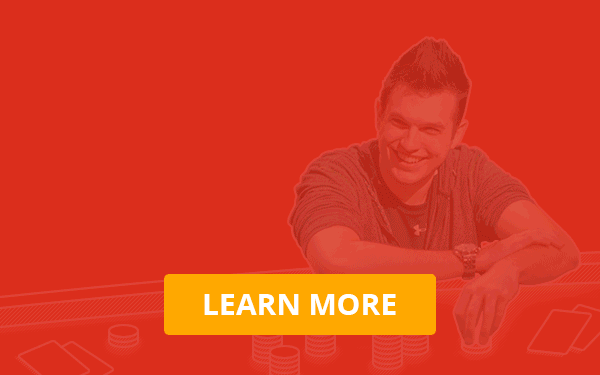How To Extract Max Value in Limit Hold’em
A few months ago I shared a list of 7 tips to help NLHE players win at limit:
- Play quickly.
- Focus on the pot size, not your opponent’s stack sizes.
- Play a lot of weak hands in the big blind.
- Big cards are king.
- Limit your coldcalling.
- Don’t bluff too often.
- Plan how to best put in bets and raises.
Some of the more nuanced tips can be expanded upon, particular #7. Planning how to best put in your raises is vital in LHE. You can only bet a set amount on each street, so maximizing value involves choosing your bets wisely.
Let’s take the first step to becoming a minbetting master.
Example: Play A Limit Hand With Me
The following hand actually occurred in a 20/40 cash game at a live casino that a student of mine played in.
Hero is dealt
in the big blind.
There are two limps, the button raises and the small blind calls.
A8o is by no means a great hand and generally a dangerous hand to call raises with in NLHE, but in LHE you can assume the limpers are also calling; meaning, you are getting 9:1 immediate odds to call with this hand, making it an easy peel here in the big blind.
The flop comes
The small blind checks, as do you and the limpers. The button bets $20 and the small blind raises to $40.
Seems like a fold, maybe a call if you think the small blind could have a draw, right? Believe it or not, the best play in this spot is almost certainly to raise!
The logic goes like this: The button can easily be betting a ton of hands weaker than yours here. He could have any draw including a hand as weak as QJ, any flush draw, or he could be protecting his hand with something like 77/AK. He could even just be bluffing with KQ. His bet is not something to be super scared of.
Now let’s think about the player in the small blind. He should know that by raising he is likely to fold out everyone behind him who doesn’t have a decently strong hand. If he had a flush draw or a really strong hand like a full house or AT, he would want to encourage people with weak hands to stay in the pot. But when he check/raises a player to his right, he forces the players behind to call two bets if they want to continue. This is going to fold out a ton of hands that would call for only one bet.
If the small blind has a draw or a hand like 87dd, this would be a colossal error for you to fold here.
“SO WHAT?” you might say. “If he has a ten, we are going to lose a lot here!” Wrong.
Compared to the size of the already juicy pot, putting in 3-bets to raise here is a relatively small investment to make to accomplish our goals.
There are 13 small bets in the pot when you have to make your decision. Let’s consider each option:
- Folding risks 0 bets.
This isn’t a good option. You have far too much potential equity to fold.
- Calling risks 2 bets
Calling is better than folding, but it leaves the door open for the limpers to enter the hand. Additionally, the button can easily call with a lot of weaker hands like overcards or a hand like QJ that has a ton of outs against you.
- 3-betting risks 3 bets.
For the price of just 1 more small bet we drive out a ton of hands with equity, and maybe even some better hands. If the button has a hand like 99 or JJ-QQ, he may think that you have a ten because you check/3bet into 4 other players. It’s 2 bets to him and he may fold thinking he got outflopped. The small blind has to be scared of the same if he has anything but a ten or a full house.
(Note: If you’re serious about improving your no limit game, check out the Upswing Lab by clicking below!) 
This perfectly illustrates a key concept in LHE: Protecting your equity in a big pot is extremely important. By calling, you charge people nothing and grant them free equity by letting them stay in a hand when they will be making a significant error by folding.
Betting and raising in big pots to protect your equity is a crucial concept in limit hold’em. This hand is a good example of that. My student 3-bet the flop and all 4 of his opponents folded! He picked up 13 small bets instantly without having to see a turn.
He probably had the best hand, but do you think he had 100% chance of winning with a pair of eights here?
Imagine if he had just coldcalled and one of the limpers came along for the ride with QJ. The button calls too with AK and the small blind has 98. Now instead of winning the pot outright, we have to dodge an ace, king, queen, jack, ten or nine to still have the best hand. Let’s run this situation in an equity calculator:
All of our opponents’ hands are quite weak on this board, but cumulatively they have 63% equity to win the pot. Despite having way-the-best hand, we’re only going to win 36% of the time. Isn’t limit poker fun?
So in a way he bluffed them with the best hand. And that’s great!
Fixed Limit-ed Opportunities
A lot of limit players tend to play extremely straightforward and predictable, failing to take advantage of situations that will earn them extra bets. It’s very important to plan your bets based on how the hand likely to play out given your opponent’s range.
This isn’t NLHE where you can bet whatever size, whenever you like to make up for lost value earlier in the hand. In limit, you have a set number of opportunities to extract value from your opponent. In certain spots you can be creative and earn yourself an extra bet or two, which is a big deal in a game where you’re trying to earn one big bet an hour.
This hand occurred at the Bellagio playing $20/$40 LHE a few weeks ago. The game is quite good with a few very loose players and an average of 4-5 players taking the flop for multiple bets every hand.
Hero is dealt
in the Small Blind
UTG opens and the button calls. I call when I see the big blind waiting to call as well (side note: don’t do what he did).
The flop comes
Action checks through
The UTG preflop raiser electing not to c-bet is an uncommon sight in limit games. This is usually a signal that he doesn’t have a super big hand here (at best something like AJ or KQ with one heart.)
The turn is the
My opponents have all signaled they don’t have very much. They might all be drawing dead or to 7 outs at the most. I can hope to extract a few bets by betting myself, hoping they call me down whilst putting me on a missed draw. But instead I choose to check.
The thing is, everything I just said about their hands is absolutely true of mine as well. I called a raise in the small blind and checked twice. My hand looks like absolutely nothing. Both the UTG player and the button checked the flop despite being heavily incentivized to bet, so they likely don’t have very much.
However, the big blind is a very loose player that is capable of checking a strong hand on the flop hoping to check/raise the field. Additionally, UTG may feel incentivized to bet a hand for protection, like ace high, once it checks to him on this brick turn. Back to the hand
The big blind bets $40. UTG raises to $80. The button folds.
In most situations it would seem as though we got trapped by a hand as strong as AhAc. Or maybe UTG is going for a free showdown with a hand like AhKc. In any case the trapper has become the trappee and HERE COMES PAPA.
I 3-bet to $120. The big blind makes a very grumpy fold and UTG calls
The river is the
I bet $40 and UTG calls.
What a beautiful river! I show my hand and UTG mucks his as I scoop the pot.
This hand history reminds me of an exchange from the West Wing.
President Barlet: “Abbey and I were walking along and we see a ditch digger, and I said, “Aren’t you glad you married me? You could’ve married a ditch digger.” And she said, “Jed, if I’d married
him, he’d be President.” What do you think?
Charlie: Not so sure, sir.
President Barlet: Why?
Charlie: Cause it seems like a story about how cool you are.
President Barlet: It is.
But you know what’s really cool? GETTING EXTRA BETS.
If I made the “standard” play of betting the turn, the big blind may have just called with a pair of sixes or sevens on this scary board. UTG would then be incentivized to just call his decent flush draw, trying to see a cheap river. Then when I bet the river one or both of them might fold.
By being a little tricky and checking the turn, I polarized my hand and made the pot significantly bigger, making it far more likely I would both induce a bet and get called down light. I got lucky that UTG also happened to slow play a potentially big hand, but preparation tends to make you lucky. In a truly just world, I would be able to check/raise the river as well, but sometimes you can’t always get what you want.
I’m planning on doing a few more entries on expanding my common LHE mistakes and tips for minbet mastery. I would love to be able to review hands and answer questions sent in by readers, so if you have a LHE hand or question please don’t hesitate to send it to [email protected].
(Note: Now that you know how to extract max value in limit, why not learn how to do it in no limit? The Upswing Lab is the best way to improve your no limit skills, but don’t take our word for it, see what our members are saying!) 